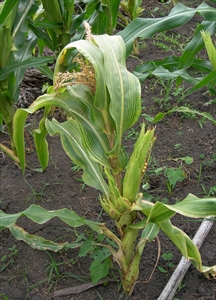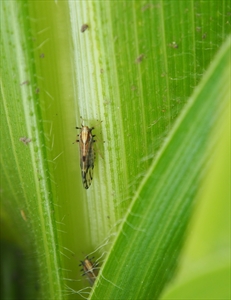Maize mosaic, corn mosaic
Pacific Pests, Pathogens, Weeds & Pesticides - Online edition
Pacific Pests, Pathogens, Weeds & Pesticides
Maize mosaic (074)
Maize mosaic nucleorhabdovirus; the abbreviation is MMV.
Asia (restricted), Africa, North (Florida, Hawaii), South and Central America, the Caribbean, Oceania. It is recorded from Fiji and Solomon Islands.
Maize, sweet corn and Rottboellia cochinchinensis (itch grass).
Apart from stunting, the virus causes light green to yellow stripes along the leaves (Photos 1&2). These stripes are either narrow, the width of a single leaf vein, or in bands 1-2 cm wide.
The virus particles are bullet-shaped when seen under the electron microscope. The virus is not seedborne, nor is it spread in infected plant material. It is spread by planthoppers, Peregrinus maidis, that live and breed on maize and the grass weed, Rottboellia cochinchinensis (Photo 3). The planthoppers feed on these plants, acquire the virus and, after a few days, during which time the virus multiplies in the insects, the planthoppers then spread it to other plants. Once infected, the planthoppers continue to spread the virus until they die.
Another virus, Maize stripe virus, causes similar symptoms in maize and Rottboellia, and is spread by Peregrinus maidis . However, this virus has not been found in Pacific island countries, but is reported from Australia. Maize stripe virus particles are long flexuous rods.
Plants are stunted, and either the cobs do not develop, or they are deformed with fewer seeds than normal. However, the number of plants infected with the disease is usually quite small, perhaps 1-2%, and so it is unlikely that yields overall are reduced greatly. Sweet corn appears to be more susceptible than maize.
Look for stunted plants, often present at or near the borders of the fields. Look for the yellow and green stripes, sometimes running the entire length of the leaves; these may be narrow, a single line or in bands, 1-2 cm wide. Importantly, look for populations of planthoppers in the 'funnel' of the young leaves; this is an indication that the symptoms (if present) are likely to be caused by Maize mosaic virus.
CULTURAL CONTROL
Pull out plants as soon as symptoms are seen. Do not wait; otherwise, the insects will breed and spread the disease. When pulling out the plants grasp the young leaves, holding them together, preventing the insects escaping from the 'funnel' of leaves. Put the plants into a sack and burn them, destroying plants and insects.
RESISTANT VARIETIES
It is likely that varieties of maize imported into Pacific island countries are from countries where maize and sweet corn have been bred for resistance to this disease.
CHEMICAL CONTROL
Chemical control is not appropriate for this disease. Although insecticides could be used to kill the planthoppers that spread the virus, their use would not be economic as the number of plants with symptoms is usually low. Removal of infected plants is a better method of control.
AUTHORS Helen Tsatsia & Grahame Jackson
Information from Maize mosaic virus (corn mosaic virus) (2019) Crop Protection Compendium. (https://www.cabi.org/cpc/datasheet/32399); and Tsai JH, Falk BW (undated) Insect vectors and their pathogens of maize in the tropics. CFANS. University of Minnesota. (https://ipmworld.umn.edu/tsai-maize-tropics); and from Kohler F, et al. (1997) Diseases of cultivated crops in Pacific Island countries. South Pacific Commission. Pirie Printers Pty Limited, Canberra, Australia. Photo 3 Richard Markham, ACIAR, Canberra.
Produced with support from the Australian Centre for International Agricultural Research under project PC/2010/090: Strengthening integrated crop management research in the Pacific Islands in support of sustainable intensification of high-value crop production, implemented by the University of Queensland and the Secretariat of the Pacific Community.






